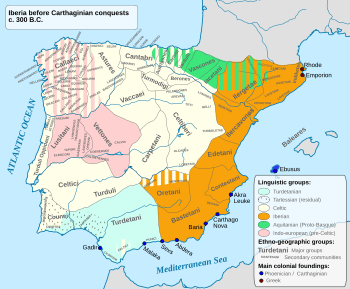Paesuri facts for kids
The Paesuri (say "Pay-SOO-ree") were an ancient group of people who lived in a region called Lusitania a long time ago, before the Romans took over. They were similar to the Lusitani people and were connected to them.
Contents
Who Were the Paesuri?
Historians learned about the Paesuri from ancient writings by Pliny the Elder, a famous Roman writer. They also found an old stone carving, called an inscription, from the 2nd century AD near Cáceres in Spain. This inscription mentions the Paesuri along with other groups from Lusitania.
It's not fully clear where the Paesuri originally came from or what language they spoke. Some experts think they might have come from a region called Thrace (modern-day Bulgaria and parts of Greece). It's also not certain how much they were influenced by their neighbors, like the Lusitani, Gallaeci, and Turduli Veteres, who spoke Celtic languages.
Where Did They Live?
The Paesuri lived in what is now the northern central part of Portugal. Their land was located between two rivers, the Douro and the Vacua (also called Vagua or Vouga).
They were made up of four smaller groups, or subtribes:
- The Ireucutiori
- The Aravoni
- The Seareae
- The Paesicaeci (or Paesici)
These groups settled in the mountains of Freita, Arada, and the northern parts of Caramulo around 500 BC.
Paesuri History and Roman Rule
Unlike some of their neighbors, the Paesuri did not come under the rule of Carthage during the late 3rd century BC. This means they probably didn't take part in the Second Punic War, a big conflict between Rome and Carthage.
It's also not clear if they played a major role in the Lusitanian Wars, which were fought in the 2nd century BC. However, they were allies with the Lusitani people. This meant they faced the first attacks when the Romans began to move into the northwestern part of the Iberian Peninsula.
In 138-136 BC, a Roman leader named Decimus Junius Brutus led a military campaign. He attacked and damaged the lands of the Paesuri. This was part of his punishment against the Lusitani and Turduli Veteres.
The Paesuri suffered similar attacks again in 61-60 BC. At this time, another Roman leader, Julius Caesar, forced them to become part of the Roman province called Hispania Ulterior.
Becoming Part of the Roman Empire
Later, between 27 and 13 BC, the Roman Emperor Augustus officially added the Paesuri's territory to the Roman province of Lusitania. This meant they became fully part of the Roman Empire.
See also
 In Spanish: Pésures para niños
In Spanish: Pésures para niños
- Bardili (Turduli)
- Gallaeci
- Turduli
- Turduli Oppidani
- Turduli Veteres
- Thracians
- Pre-Roman peoples of the Iberian Peninsula


